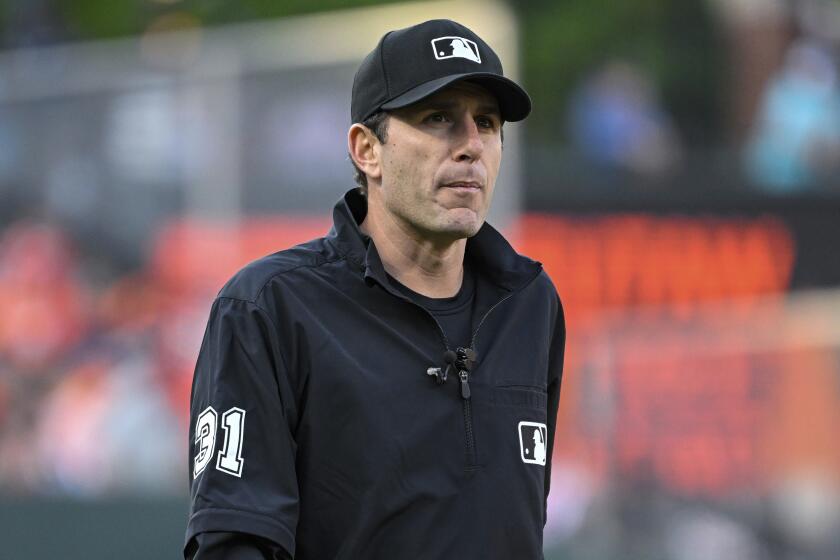TENNIS / THOMAS BONK : In Budge’s View, Wimbledon Still Classiest Tournament
- Share via
When Don Budge was a kid growing up in Oakland, sometimes he would ride the ferry across the Bay to San Francisco and pretend he was on board a great ship that was taking him to England to play Wimbledon.
“It was a little game I played with myself,” Budge said. “I just dreamed about eventually getting over there.”
Of course, Budge eventually did get over there and managed to make the most of his appearances. Two of his six Grand Slam singles titles were Wimbledon championships, in 1937 and 1938, when tennis was a great deal, well, different from its modern counterpart.
Improvements in equipment, as well as innovations in playing surfaces, have drastically altered the game. But Wimbledon probably isn’t all that far removed from that day in 1935 when a 20-year-old Budge saw tennis’ hallowed grass courts for the first time.
He had taken a five-day journey by boat from New York to Southampton, then boarded a train for London and arrived in the late afternoon. After checking into his hotel, Budge ran outside and took a taxi to Wimbledon.
“I had to see it,” he said. “Even though I was practicing there the next morning, I couldn’t wait.”
There is simply no other tournament like Wimbledon, said Budge, 76, who lives in Dingman’s Ferry, Pa.
“If you asked all the players which tournament they would most want to win, I’ll bet almost 100% would say Wimbledon. When I won Wimbledon, you were world champion.”
And Wimbledon remains Wimbledon. It covers itself with tradition and clings to its past like the ivy that hugs the red brick walls ringing the property.
In Budge’s era, Wimbledon officials dispatched Rolls-Royces and Daimlers to pick up the players at their hotels and flats to bring them to the courts and then take them back home. The mode of travel that got the players that far was equally elegant.
The boat trip to England reflected a more genteel era in which passengers would merely set their watches ahead an hour each day to adjust gradually to the five-hour time change from New York. However, the effects of boat lag needed to be recalculated for transatlantic trips on the speedier Normandy or Queen Mary, which needed only 2 1/2 days to cross.
At Wimbledon, the reverence for the past permeates all, and if it is suffocating to some, it certainly is not to Budge.
“I think it’s the most classy tournament in existence,” he said. “They really know how to put on a show there. To me, it’s so traditional. Some things have changed, such as the game, of course.
“The game has changed a little bit because of the new rackets. The new rackets are much faster, which they are, but the ball is slower now, so one counteracts the other. Slazenger makes the balls and they had pressurized balls left from the 1930s and tested them against today’s balls and found that the ball is much slower now.”
In Budge’s day, the Slazenger ball used at Wimbledon had a wool cover. The cover of the ball now being used at Wimbledon is 30% wool, 30% Dacron, 30% nylon and the remainder another synthetic material, all of which means that the ball isn’t as lively as it was in his day, Budge said.
Scheduling differs, too. When Budge played, five matches were put on beginning at the traditional 2 p.m. main court start time. Now, only three matches are scheduled. Budge said that today’s play lasts too long.
“They ought to speed it up by having continuous play,” he said. “When I played, there were no chairs on the court. The players just toweled off as we stood beside the umpire’s chair.
“And I think all this ball-bouncing between points is so pointless. Someone did a survey once on a five-set match and used a stop watch to gauge the ball-bouncing. Guess how much time was time was taken up just bouncing the ball. Forty-seven minutes. We’ve heard people sit up in the stands and say, ‘We didn’t come here to watch them bounce the ball.’ It’s really ridiculous, I think.”
The grass: It would be a mistake if Wimbledon ever changed its surface from grass, according to Budge.
“I would hate to see it,” he said. “It’s a challenge to the players to play on different surfaces. It brings out the true test of a tennis player. Poor (Ivan) Lendl has never won a grass-court tournament of any value, but when I won the Grand Slam, three of the four were on grass. It would be a shame to change Wimbledon. It’s tradition.”
Dress whites: Budge said he really admires Wimbledon’s tradition of requiring players to wear predominantly white attire on the court, if only for one reason: “Making Agassi wear white instead of those weird costumes he wears everywhere else.”
Old times: When 34-year-old Martina Navratilova lost in straight sets to 15-year-old Jennifer Capriati in the quarterfinals, it represented a changing of the guard. Navratilova, appearing in her 17th consecutive Wimbledon singles quarterfinal, lost to someone who was not born when Navratilova made her Wimbledon debut.
Navratilova, a nine-time Wimbledon champion, played her first match at Wimbledon in 1973. Capriati was born in 1976.
Navratilova’s poorest Wimbledon result since she lost in the quarterfinals in 1977 might be traced to the distraction of the suit filed against her last month by her former companion, Judy Nelson.
Nevertheless, Navratilova said she was not ready to quit.
Old times II: John McEnroe, 32, was blown out in three sets by Stefan Edberg, who seemed to signal the end of the Mac era at Wimbledon as well. McEnroe can no longer challenge the elite, Edberg said after winning their fourth-round match.
“I think it’s too late,” Edberg told Reuters. “He played his best tennis back in 1983 or 1984. I still believe he can play some very good tennis, but he’s not as consistent as he was before. He has lost a bit of speed as well.”
McEnroe was asked if he could win Wimbledon a third time.
“It’s a long shot but hope springs eternal,” he said. “Stranger things have happened. If it did happen, I wouldn’t be in shock. But I’m not going to pledge my life savings on it, or even a portion of them.”
More to Read
Go beyond the scoreboard
Get the latest on L.A.'s teams in the daily Sports Report newsletter.
You may occasionally receive promotional content from the Los Angeles Times.










